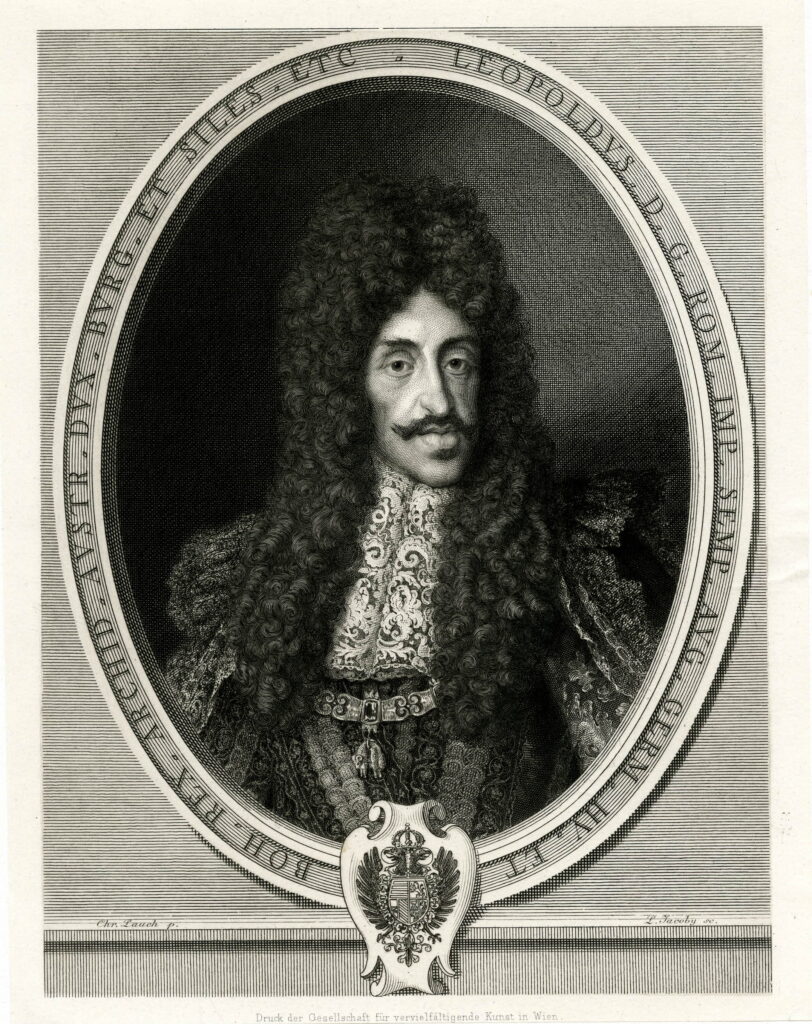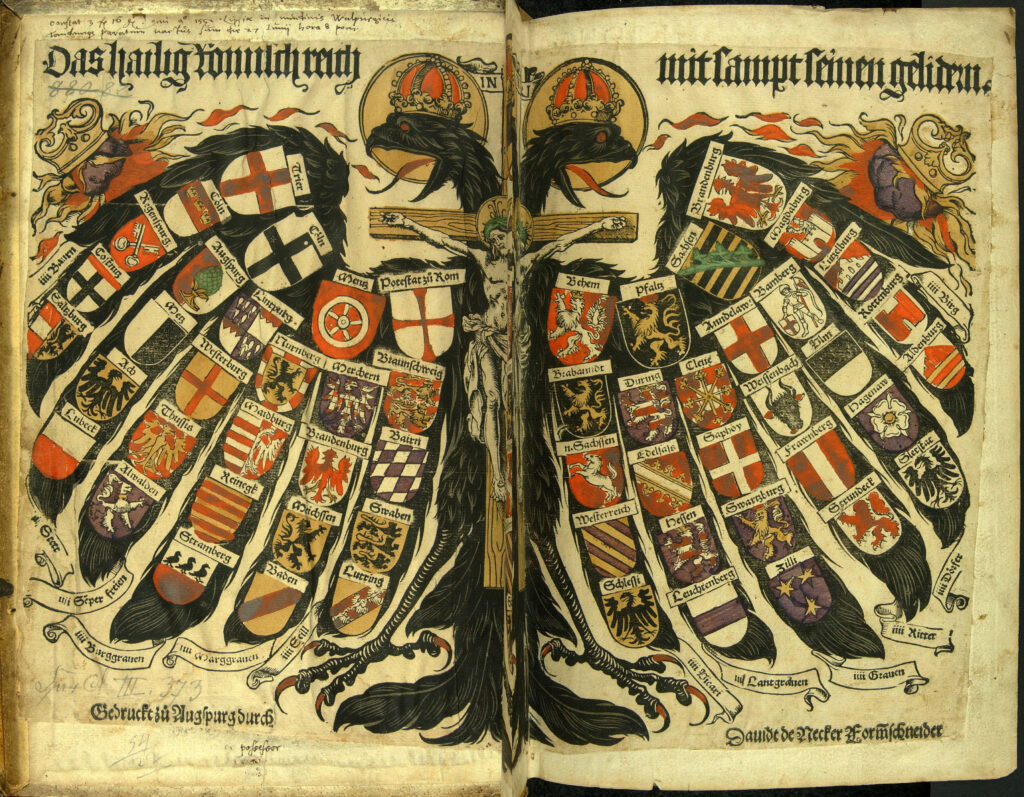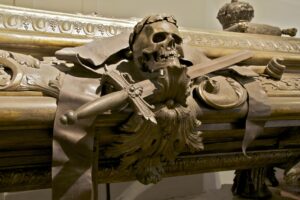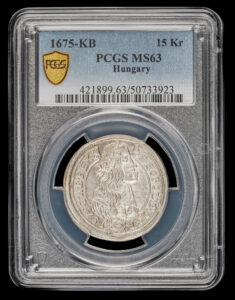
1675 15 Kreuzer PCGS MS-63
Item #CC-0585 | 1675 15 Kreuzer PCGS MS-63
Mint: KB Kremnitz (Modern Day Slovakia)
Ruler/Period: King Leopold I
Grade: MS-63
For details and population on this coin from PCGS, click on the serial number here: 50733923
Description: This beautiful and rare 1675 15 Kreuzer is currently one of the finest examples graded by PCGS. It was minted during the reign of King Leopold I (June 9, 1640 –May 5, 1705), who was also known as the “Holy Roman Emperor” of the Austrian Hungarian empire. During the period this coin was made, coins like this were typically used for day-to-day transactions and precious few have survived in uncirculated condition, especially ones in choice uncirculated condition. During the reign of Leopold I, a lot of significant world events and wars took place which makes the story surrounding this coin truly amazing, so let’s dive in!
 Leopold I was nicknamed “The Hogmouth” as a result of a facial deformity that was a Habsburg family trait where he had an enlarged lower lip and protruding jaw. It is doubtful that anyone in his kingdom would dare call him that to his face, but the derogatory epithet has made its way down through history. To this day, coinage bearing his image are often referred to as Hogmouth type.
Leopold I was nicknamed “The Hogmouth” as a result of a facial deformity that was a Habsburg family trait where he had an enlarged lower lip and protruding jaw. It is doubtful that anyone in his kingdom would dare call him that to his face, but the derogatory epithet has made its way down through history. To this day, coinage bearing his image are often referred to as Hogmouth type.
Design Features of the Coin
The obverse legend on this coin is in Latin and the abbreviations represent: LEOPOLD D[EI] G[RATIA] R[OMANORVM] I[MPERATOR] S[EMPER] A[VGVSTVS] G[ERMANIAE] H[VNGARIAE] B[OHEMIAE] REX. The translation reads: “Leopold, by the Grace of God, Emperor of the Romans always august, King of Germany, Hungary and Bohemia”. The denomination (XV) is encircled at the bottom.
The reverse side displays a glorified and crowned Madonna holding a scepter in her right hand and the Holy Child representing Jesus holding the world next to his heart. On either side of the Madonna are two letters (KB) that represent the Kremnitz mint mark. The legend reads: PATRONA HVNGARIÆ · 1675. In English, this translates to: “Patron of Hungary 1675”. Below the Madonna is the Hungarian coat of arms.
When mechanical coining presses began to replace coins struck by hand, two different technologies were tried. One was a screw type press and the other was the “Roller Press”. The roller press made several die impressions on a pair of rollers and a strip of coin metal was sandwiched between them as they turned. The resulting strip of coins were then punched out. Unlike hammer struck coins where each blank had to be placed by hand on the anvil die and struck, and then removed by hand, the roller press provided a significant savings in time. However, the finished coins would be slightly curved as can be seen on this piece. The down side was that they would not stack well, and one side wore much faster than the other.
Leopold’s Early Life and Rise to Power
Leopold I was a prominent figure in European history, known for his long and impactful reign as the Holy Roman Emperor from 1658 until his death in 1705. He was the King of Hungary, Croatia, and Bohemia, and a member of the influential Habsburg dynasty.
Leopold was born in Vienna, the second son of Ferdinand III, Holy Roman Emperor, and Maria Anna of Spain. Initially destined for a career in the Church, Leopold’s path changed dramatically after the sudden death of his elder brother, Ferdinand IV, in 1654. This unexpected turn of events made Leopold the heir apparent, and he was elected and crowned as the Holy Roman Emperor in 1658.
 Leopold’s reign is marked by significant military conflicts, particularly against the Ottoman Empire and France. His most notable military achievement was his victory in the Great Turkish War (1683 – 1699). With the help of Prince Eugene of Savoy, Leopold successfully pushed the Ottoman forces back and recovered almost all of the Kingdom of Hungary through the Treaty of Karlowitz. This victory was crucial in securing the Habsburgs’ eastern frontiers and establishing Austria as a major European power.
Leopold’s reign is marked by significant military conflicts, particularly against the Ottoman Empire and France. His most notable military achievement was his victory in the Great Turkish War (1683 – 1699). With the help of Prince Eugene of Savoy, Leopold successfully pushed the Ottoman forces back and recovered almost all of the Kingdom of Hungary through the Treaty of Karlowitz. This victory was crucial in securing the Habsburgs’ eastern frontiers and establishing Austria as a major European power.
Leopold also engaged in three other wars against France: the Franco-Dutch War (1672-1678), the Nine Years’ War (1688-1697), and the War of the Spanish Succession (1701 – 1714). Although the latter conflict continued beyond his death, Leopold’s efforts in these wars showcased his determination to expand and secure Habsburg influence in Europe.
The War of the Spanish Succession was a European great power conflict fought between 1701 and 1714. The immediate cause was the death of the childless Charles II of Spain in November 1700, which led to a struggle for control of the Spanish Empire between supporters of the French Bourbons and the Habsburgs. Charles named his heir as Philip of Anjou, (Philip V of Spain (1683–1746) a grandson of Louis XIV of France, whose claim was backed by France and most of Spain. His rival, Archduke Charles of Austria, was supported by the Grand Alliance, whose primary members included Austria, the Dutch Republic, and Great Britain.
Although by 1701 Spain was no longer the predominant European power, its global empire still included the Spanish Netherlands, large parts of Italy, and the Americas. Its acquisition by either France or Austria threatened the European balance of power, and Philip’s proclamation as king of Spain on November 16, 1700 led to war. The French held the advantage in the early stages but were forced onto the defensive after 1706. Although the Allies continued to advance in northern France, by 1709 Philip had cemented his position in Spain, the ostensible cause of the war.
Philip was confirmed as king of Spain but renounced his claim and those of his descendants to the French throne. The Spanish Empire ceded much of its Italian territories to Savoy and Austria, along with the Spanish Netherlands, although it remained largely intact outside Europe.
 The sarcophagus of Leopold I shown here is located in Vienna, Austria.
The sarcophagus of Leopold I shown here is located in Vienna, Austria.
This coin is a wonderful and rare piece of history and would make a great addition to any world coin collection!
In stock
$425.00

